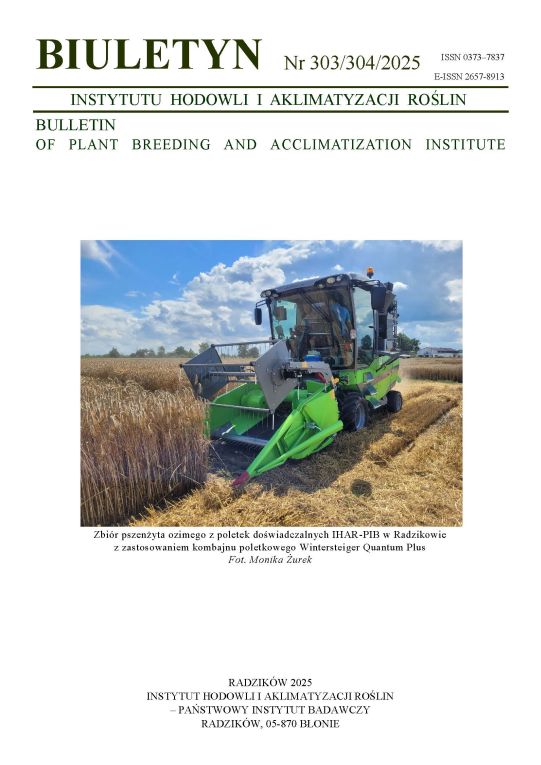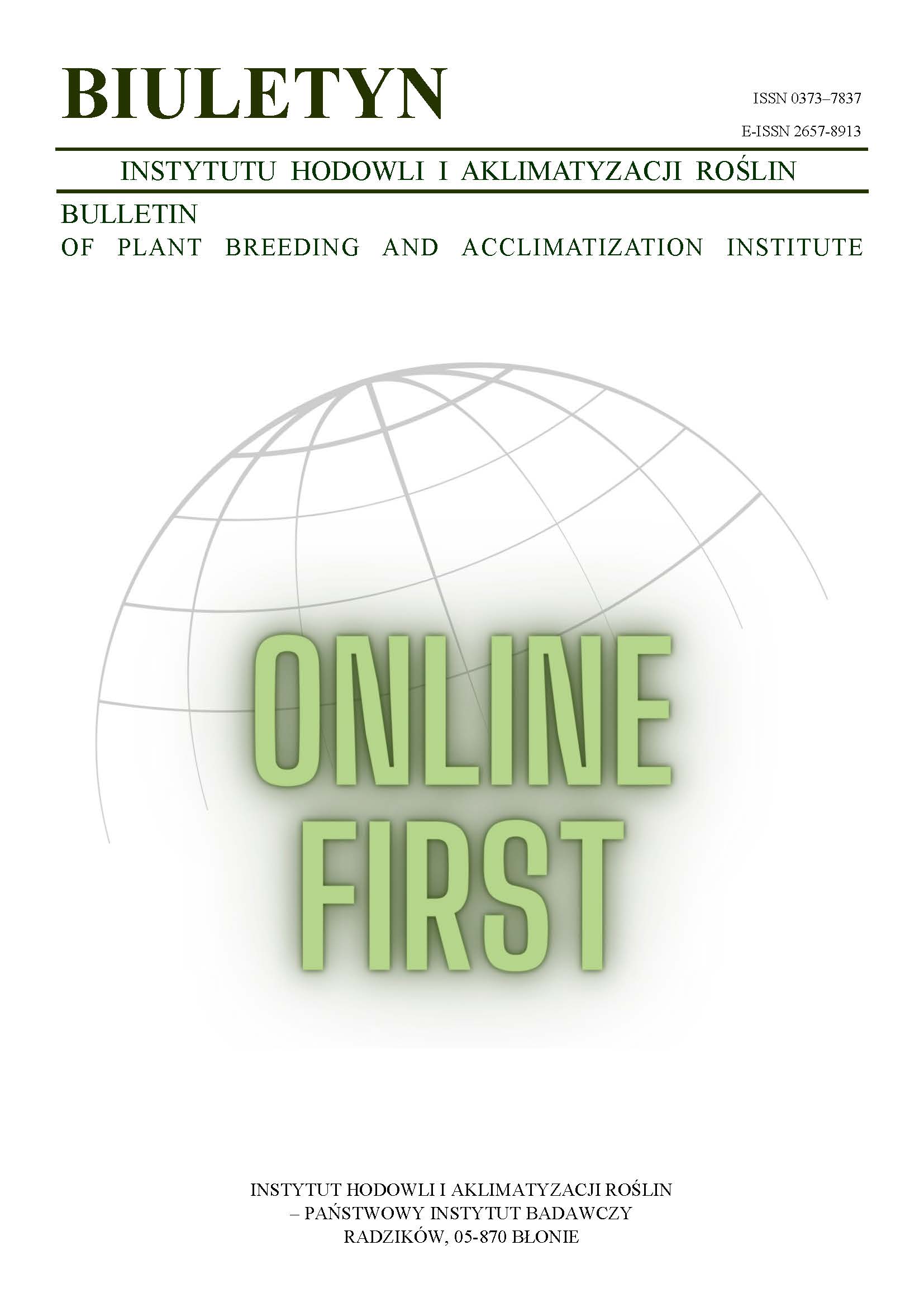Development of bacterial ring rot infection in potato plants reproduction
Teresa Pastuszewska
t.pastuszewska@ihar.edu.plPracownia Chorób i Szkodników Kwarantannowych Ziemniaka, Instytut Hodowli i Aklimatyzacji Roślin, Oddział w Bydgoszczy (Poland)
Iwona Junosza-Kisielewska
Pracownia Chorób i Szkodników Kwarantannowych Ziemniaka, Instytut Hodowli i Aklimatyzacji Roślin, Oddział w Bydgoszczy (Poland)
Weronika Grzech
Katedra Fitopatologii, Akademia Techniczno-Rolnicza, Bydgoszcz (Poland)
Sebastian Brzozowski
Katedra Fitopatologii, Akademia Techniczno-Rolnicza, Bydgoszcz (Poland)
Abstract
The development of bacterial ring rot symptoms in 8 samples of progeny tubers (90–180 tubers per sample), in which latent infection was detected by immunofluorescence methods, was examined in a field experiment in 2001–2003. First bacterial ring rot symptoms on leaves appeared in the 8th week after tubers planting in samples 27, 40, 170 and 187 (6% of leaves infested). They consisted of wilting of lower leaves, overcolouring and rolling of leaves margins inwards. Progeny tubers were examined twice a year, in autumn and in spring. Internal tuber symptoms ranged from glassy to cream — yellow zones along the vascular tissue near the stolon. In later stages of the disease yellowish rings were observed. Maximum percentage (21.6%) of tubers with visible symptoms was found in a sample no. 170.
Keywords:
bacterial ring rot, latent infection, immunofluorescence method, plants, tubers, symptomsReferences
Akeley R. V., Stevenson F. J., Blood P. T., Schultz E. S., Bonde R., Nielsen K. F. 1955. Merrimack. A new variety of potato resistant to late blight and ring rot and adapted to New Hampshire. Am. Potato J. 32: 93.
DOI: https://doi.org/10.1007/BF02851157
Google Scholar
Anonim. 1990. Quarantine procedure. Clavibacter michiganensis ssp. sepedonicus. Inspection and test methods. Bulletin OEPP/EPPO Bulletin 20: 235 — 254.
DOI: https://doi.org/10.1111/j.1365-2338.1990.tb01204.x
Google Scholar
Bonde R., Stevenson F. J., Clark C. F., Akeley R. V. 1942. Resistance of certain potato varieties and seedling progenies to ring rot. Phytopathology 32: 813 — 819.
Google Scholar
Bishop A. L., S. A. Slack, 1987. Effect of cultivar, inoculum dose and strain of Clavibacter michiganensis subsp. sepedonicus on symptom development in potatoes. Phytopathology 77: 1085 — 1089.
DOI: https://doi.org/10.1094/Phyto-77-1085
Google Scholar
Bonde R., Stevenson F. J., Akeley R. V. 1947. Breeding potatoes for resistance to ring rot. Phytopathology 37: 539 — 555.
Google Scholar
Calzolari A., Bazzi C., Mazucchi U. 1982. Cross reactions between Corynebacterium sepedonicum and Arthobacter polychromogenes in immunofluorescence staining. Potato Research 25: 239 — 246.
DOI: https://doi.org/10.1007/BF02357308
Google Scholar
Crowley C. F., De Boer S. H., 1982. Non-pathogenic bacteria associated with potato stems cross-react with Corynebacterium sepedonicum antisera in immunofluorescence. Am. Potato J. 59: 1 — 8.
DOI: https://doi.org/10.1007/BF02854878
Google Scholar
De Boer S. H., Wieczorek A. 1984. Production of monoclonal antibodies of Corynebacterium sepedonicum. Phytopathology 74: 1431 — 1433.
DOI: https://doi.org/10.1094/Phyto-74-1431
Google Scholar
De Boer S. H., McNaughton M. E. 1986. Evaluation of immunofluorescence with monoclonal antibodies for detecting latent bacterial ring rot infections. Am. Potato J. 63: 533 — 542.
DOI: https://doi.org/10.1007/BF03044053
Google Scholar
De Boer S. H., Mc Cann M. 1990. Detection of Corynebacterium sepedonicum in potato cultivars with different propensities to express ring rot symptoms. Am. Potato J. 67: 85 — 694.
DOI: https://doi.org/10.1007/BF03044015
Google Scholar
De Boer S. H., Janse J. D., Stead D. E., Van Vaerenbergh J., Mc Kenzie A. R, 1992a. Detection of Clavibacter michiganensis subsp. sepedonicus in potato stems and tubers grown from seed pieces with various levels of inoculum. Potato Research 35: 202 — 216.
DOI: https://doi.org/10.1007/BF02357617
Google Scholar
De Boer S. H., Van Vaerenbergh J., Stead D. E., Janse J. D., Mc Kenzie A. R. 1992b.A comparative study in five laboratories on detection of Clavibacter michiganensis subsp. sepedonicus in potato stems and tubers. Potato Research 35: 217 — 226.
DOI: https://doi.org/10.1007/BF02357618
Google Scholar
Dykstra T. P. 1941. Results of experiments in control of bacterial ring rot of potatoes in 1940. Am. Potato J. 18: 27 — 55.
DOI: https://doi.org/10.1007/BF02893261
Google Scholar
Dykstra T. P. 1942. Compilation of results in control of bacterial ring rot in 1941. Am. Potato J. 19: 175 — 196.
DOI: https://doi.org/10.1007/BF02850505
Google Scholar
Dyrektywa EEC Nr 93/85. Officinal Journal L 259.18.10.1993.
DOI: https://doi.org/10.1017/S0307883300017247
Google Scholar
EPPO/CABI. 1997. Quarantine Pests for Europe. Second edition: 986 — 990.
Google Scholar
Firrao G. R., R. Lozzi. 1994. Identification of Clavibacter michiganensis subsp. sepedonicus using polymerase chain reaction. Can. J. Microbiol. 40: 148 — 151.
DOI: https://doi.org/10.1139/m94-024
Google Scholar
Gamard P., De Boer S.H. 1995. Evaluation of antagonistic bacteria for suppression of bacterial ring rot of potato. Eur. J. Plant Pathology. 101: 519 — 525.
DOI: https://doi.org/10.1007/BF01874476
Google Scholar
Kawchuk L. M., Lynch D. R., Kozub G. C., Nelson G. A., F. Kulcsar, Fujimoto D. K. 1998. Multi-year evaluation of Clavibacter michiganensis subsp. sepedonicus disease symptoms in cultivated potato genotypes. Am. J. of Potato Research 75: 235 — 243.
DOI: https://doi.org/10.1007/BF02853602
Google Scholar
Kriel C. J., Jansky S. H., Gudmestad N. C., Ronis D. H. 1995. Immunity to Clavibacter michiganensis subsp. sepedonicus: Screening of exotic Solanum species. Euphytica 82: 125 — 132.
DOI: https://doi.org/10.1007/BF00027058
Google Scholar
Lansade M. 1950. Recherches sur le fletrissment bacterien de la pomme de terre en France Corynebacterium sepedonicum (S. et K.) Skapt. et Burkh. Ann. Epiphyt. 2: 69 — 156.
Google Scholar
Manzer F. E., Gudmestad N. C., Nelson G. A. 1987. Factors affecting infection, disease development and symptom expression of bacterial ring rot. Am. Potato J. 64: 641 — 676.
DOI: https://doi.org/10.1007/BF02853913
Google Scholar
Nelson G. A., Lynch D. R., Kozub G. C. 1992. Ring rot symptom development on potato cultivars and lines in southern Alberta. Potato Res. 35: 133 — 142.
DOI: https://doi.org/10.1007/BF02357606
Google Scholar
Nelson G.A., Semeniuk G. 1964. An antagonistic variant of Corynebacterium insidiosum and some properties of the inhibitor. Phytopathology 54: 330 — 335.
Google Scholar
Pastrik K.H., Rainey F.A. 1999. Identification and differentiation of Clavibacter michiganensis subsp. sepedonicus by polymerase chain reaction — based techniques. J. Phytopathology 147: 687 — 693.
DOI: https://doi.org/10.1046/j.1439-0434.1999.00442.x
Google Scholar
Pastuszewska T. 1999. Badania nad sposobami wykrywania i eliminacji Clavibacter michiganensis subsp. sepedonicus w roślinach ziemniaka. Praca doktorska wykonana w Instytucie Hodowli i Aklimatyzacji Roślin w Bydgoszczy.
Google Scholar
Riedl W. A., Stevenson F. J., Bonde R. 1946. The Teton potato, a new variety resistant to ring rot. Am. Potato J. 23: 379 — 309.
DOI: https://doi.org/10.1007/BF02884582
Google Scholar
Schneider B. J., Zhao J. L. Orser C. D. 1993. Detection of Clavibacter michiganensis subsp. sepedonicus by DNA amplification. FEMS Microbiol. Lett. 109: 207 — 212.
DOI: https://doi.org/10.1111/j.1574-6968.1993.tb06169.x
Google Scholar
Secor G. A., De Buhr L., Gudmestad N. C. 1987. Chemical sanitation for bacterial ring rot control. Am. Potato J. 64: 699 — 698.
Google Scholar
Slack S. A. 1987. Biology and ecology of Corynebacterium sepedonicum. Am. Potato J. 64: 665 — 669.
DOI: https://doi.org/10.1007/BF02853912
Google Scholar
Westra A. A. G., Slack S. A., Drennan J.L. 1994. Com
Google Scholar
Authors
Teresa Pastuszewskat.pastuszewska@ihar.edu.pl
Pracownia Chorób i Szkodników Kwarantannowych Ziemniaka, Instytut Hodowli i Aklimatyzacji Roślin, Oddział w Bydgoszczy Poland
Authors
Iwona Junosza-KisielewskaPracownia Chorób i Szkodników Kwarantannowych Ziemniaka, Instytut Hodowli i Aklimatyzacji Roślin, Oddział w Bydgoszczy Poland
Authors
Weronika GrzechKatedra Fitopatologii, Akademia Techniczno-Rolnicza, Bydgoszcz Poland
Authors
Sebastian BrzozowskiKatedra Fitopatologii, Akademia Techniczno-Rolnicza, Bydgoszcz Poland
Statistics
Abstract views: 72PDF downloads: 26
License
Copyright (c) 2004 Teresa Pastuszewska, Iwona Junosza-Kisielewska, Weronika Grzech, Sebastian Brzozowski

This work is licensed under a Creative Commons Attribution-ShareAlike 4.0 International License.
Upon submitting the article, the Authors grant the Publisher a non-exclusive and free license to use the article for an indefinite period of time throughout the world in the following fields of use:
- Production and reproduction of copies of the article using a specific technique, including printing and digital technology.
- Placing on the market, lending or renting the original or copies of the article.
- Public performance, exhibition, display, reproduction, broadcasting and re-broadcasting, as well as making the article publicly available in such a way that everyone can access it at a place and time of their choice.
- Including the article in a collective work.
- Uploading an article in electronic form to electronic platforms or otherwise introducing an article in electronic form to the Internet or other network.
- Dissemination of the article in electronic form on the Internet or other network, in collective work as well as independently.
- Making the article available in an electronic version in such a way that everyone can access it at a place and time of their choice, in particular via the Internet.
Authors by sending a request for publication:
- They consent to the publication of the article in the journal,
- They agree to give the publication a DOI (Digital Object Identifier),
- They undertake to comply with the publishing house's code of ethics in accordance with the guidelines of the Committee on Publication Ethics (COPE), (http://ihar.edu.pl/biblioteka_i_wydawnictwa.php),
- They consent to the articles being made available in electronic form under the CC BY-SA 4.0 license, in open access,
- They agree to send article metadata to commercial and non-commercial journal indexing databases.
Most read articles by the same author(s)
- Sebastian Brzozowski, Cross-reactions of polyclonal antibodies in the immuno-fluorescence antibody staining (IFAS) test used for detecting Clavibacter michiganensis subsp. sepedonicus , Bulletin of Plant Breeding and Acclimatization Institute: No. 244 (2007): Regular issue
- Teresa Pastuszewska, Katarzyna Franke, Mirosław Nowakowski, Effect of white mustard on density of potato cyst nematode (Globodera rostochiensis) population in soil , Bulletin of Plant Breeding and Acclimatization Institute: No. 269 (2013): Regular issue
- Teresa Pastuszewska, Grzegorz Gryń, Water as a potential source of Clavibacter michiganensis ssp. sepedonicus dissemination , Bulletin of Plant Breeding and Acclimatization Institute: No. 252 (2009): Regular issue
- Teresa Pastuszewska, Grzegorz Gryń, Cellulolytic activity and virulence of Clavibacter michiganensis subsp. sepedonicus , Bulletin of Plant Breeding and Acclimatization Institute: No. 270 (2013): Regular issue
- Milena Pietraszko, Grzegorz Gryń, Teresa Pastuszewska, Włodzimierz Przewodowski, Agnieszka Przewodowska, Susceptibility of potato cultivars to infection by bacteria Clavibacter michiganensis subsp. sepedonicus in different soil conditions , Bulletin of Plant Breeding and Acclimatization Institute: No. 277 (2015): Regular issue
- Teresa Pastuszewska, Grzegorz Gryń, Małgorzata Lisowska, Agnieszka Węgierek, Pathogenicity of the Clavibacter michiganensis ssp. sepedonicus isolates to eggplant (Solanum melongena) and potato (Solanum tuberosum) , Bulletin of Plant Breeding and Acclimatization Institute: No. 257/258 (2010): Regular issue
- Teresa Pastuszewska, Sebastian Brzozowski, The diagnosis of latent form of potato ring rot (Clavibacter michiganensis subsp. sepedonicus). Pathogenicity test on eggplants (Solanum melongena L.) , Bulletin of Plant Breeding and Acclimatization Institute: No. 242 (2006): Special issue














